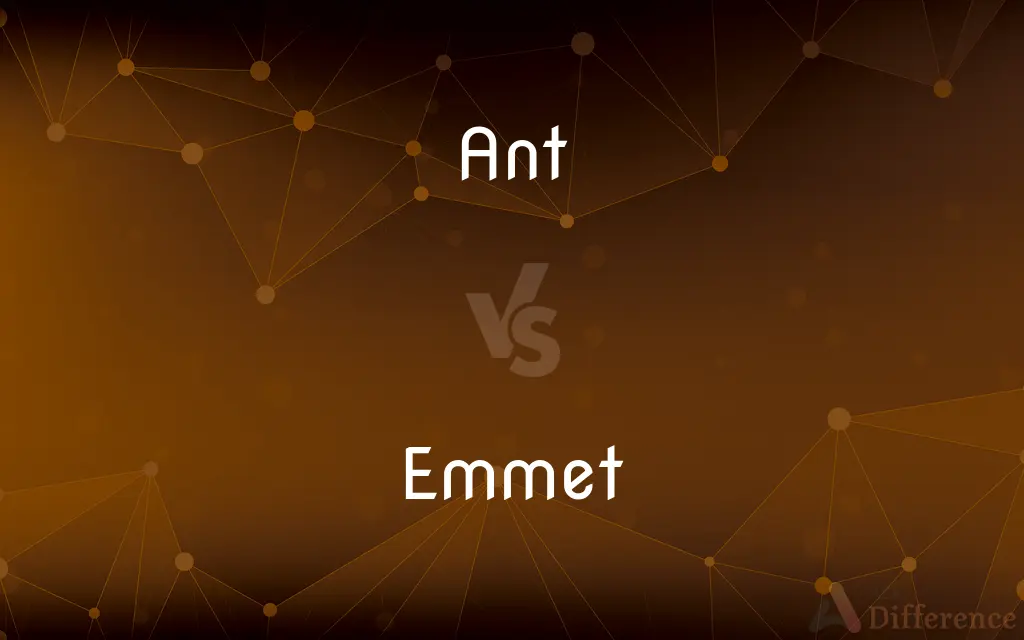Ant vs. Emmet — What's the Difference?
By Tayyaba Rehman & Urooj Arif — Updated on March 19, 2024
Ants are social insects known for their structured colonies, while "emmet" is simply an archaic or dialectical term for ant, with no difference in meaning.

Difference Between Ant and Emmet
Table of Contents
ADVERTISEMENT
Key Differences
Ants, recognized globally for their complex social structures and ability to work collectively, are a common subject of study in both entomology and popular culture. They are known for their roles in ecosystems as decomposers and predators of pests. On the other hand, the term "emmet" refers to the same insect but is less commonly used, primarily found in historical texts or certain English dialects. It does not denote a different species or type of ant but is simply an alternative name.
Both terms describe the same insect that can be found in nearly every terrestrial habitat on Earth. Ants are admired for their strength, social organization, and the variety of roles they play within their colonies, such as workers, soldiers, and queens. Similarly, when one refers to an "emmet," they are invoking an older or more regional way to talk about these same creatures and their societal behaviors.
In literature and folklore, ants are often symbols of hard work, perseverance, and communal effort. The term "emmet" might appear in older texts or regional works, emphasizing the same qualities but with a linguistic flavor that reflects a particular time or place.
The scientific study of ants, myrmecology, does not differentiate between ants and emmets, as they are considered the same. Researchers and scientists worldwide use the term "ant" in their studies, highlighting the global acceptance of the term over "emmet."
Despite the difference in terminology, the cultural and ecological perceptions of ants and emmets remain consistent. They are respected for their ability to form complex societies, their ecological importance, and the metaphorical lessons humans draw from their behavior.
ADVERTISEMENT
Comparison Chart
Definition
A social insect known for its structured colonies and roles within.
An archaic/dialectical term for ant, no difference in species.
Usage
Commonly used globally.
Used historically or in certain dialects.
Symbolism
Hard work, perseverance, communal effort.
Same as ant, with regional linguistic flavor.
Scientific Study
Studied under myrmecology.
Same insect, no separate scientific study.
Cultural Perception
Seen as industrious and organized.
Reflects similar perceptions, with a nod to linguistic heritage.
Compare with Definitions
Ant
Social insects with a complex colony structure.
The ant colony efficiently divided tasks among workers, soldiers, and the queen.
Emmet
Appears in historical or regional texts.
Classic literature may refer to ants as emmets, showcasing linguistic diversity.
Ant
Found in nearly all terrestrial habitats.
From rainforests to deserts, ants adapt to diverse environments.
Emmet
An old or dialectal term for ant.
In some English dialects, children might be told to watch out for emmets in the garden.
Ant
Symbols of diligence and cooperation.
Fables often use ants to teach lessons about hard work and planning for the future.
Emmet
Refers to the same insect as "ant" without differences.
Emmets, like ants, form structured colonies with various roles.
Ant
Known for their strength and teamwork.
Ants can lift many times their own body weight, showcasing remarkable strength.
Emmet
Symbolizes the same qualities as ants.
Emmets are also admired for their hard work and community spirit in folklore.
Ant
Play significant roles in ecosystems.
Ants contribute to soil aeration and the control of pest populations.
Emmet
Represents a linguistic variation.
The term emmet is a reminder of the rich tapestry of English language and its regional variations.
Ant
Ants are eusocial insects of the family Formicidae and, along with the related wasps and bees, belong to the order Hymenoptera. Ants appear in the fossil record across the globe in considerable diversity during the latest Early Cretaceous and early Late Cretaceous, suggesting an earlier origin.
Emmet
An ant.
Ant
Any of numerous hymenopteran insects of the family Formicidae, characteristically having wings only in the males and fertile females and living in colonies that have a complex social organization.
Emmet
An ant.
Ant
Any of various insects in the family Formicidae in the order Hymenoptera, typically living in large colonies composed almost entirely of flightless females.
Emmet
A tourist.
Ant
(Internet) A Web spider.
Emmet
An ant.
Ant
(ornithology) To rub insects, especially ants, on one's body, perhaps to control parasites or clean feathers.
Emmet
Social insect living in organized colonies; characteristically the males and fertile queen have wings during breeding season; wingless sterile females are the workers
Ant
A hymenopterous insect of the Linnæan genus Formica, which is now made a family of several genera; an emmet; a pismire.
Ant
Social insect living in organized colonies; characteristically the males and fertile queen have wings during breeding season; wingless sterile females are the workers
Common Curiosities
What is an emmet?
Emmet is an archaic or dialectical term for an ant, with no difference in species or behavior.
Can "emmet" be used in scientific contexts?
In scientific contexts, the term "ant" is preferred for clarity and global understanding, though "emmet" might appear in historical or regional studies.
Why might someone use the term "emmet" today?
Using "emmet" today might reflect a desire to connect with historical or regional language, or simply a personal preference.
Is the study of ants also the study of emmets?
Yes, the study of ants (myrmecology) encompasses all ants, regardless of the term used to describe them.
What do ants symbolize in culture and literature?
Ants symbolize hard work, perseverance, and communal effort, traits that are mirrored when the term "emmet" is used in a cultural context.
How do ants contribute to their ecosystems?
Ants play crucial roles as decomposers, pest controllers, and soil aerators, contributing significantly to ecological balance.
Do ants have the same importance in all cultures?
While cultural perceptions can vary, ants are generally respected for their industriousness and community structure across cultures.
Are there any biological differences between ants and emmets?
No, there are no biological differences; "emmet" is simply another name for the same insect known as an ant.
Why is the term "ant" more commonly used than "emmet"?
"Ant" is the globally accepted term in both common language and scientific discourse, while "emmet" is restricted to historical or regional uses.
How do language and dialect influence the terms we use for animals like ants?
Language and dialect can significantly influence the terms used for animals, reflecting regional identities, histories, and cultural nuances.
Share Your Discovery

Previous Comparison
Prove vs. Test
Next Comparison
Doodle vs. DrawAuthor Spotlight
Written by
Tayyaba RehmanTayyaba Rehman is a distinguished writer, currently serving as a primary contributor to askdifference.com. As a researcher in semantics and etymology, Tayyaba's passion for the complexity of languages and their distinctions has found a perfect home on the platform. Tayyaba delves into the intricacies of language, distinguishing between commonly confused words and phrases, thereby providing clarity for readers worldwide.
Co-written by
Urooj ArifUrooj is a skilled content writer at Ask Difference, known for her exceptional ability to simplify complex topics into engaging and informative content. With a passion for research and a flair for clear, concise writing, she consistently delivers articles that resonate with our diverse audience.














































